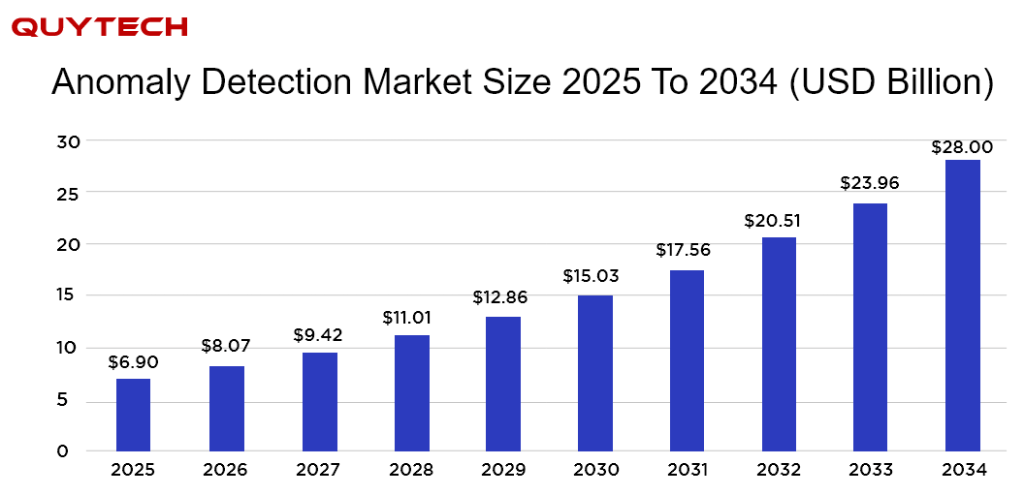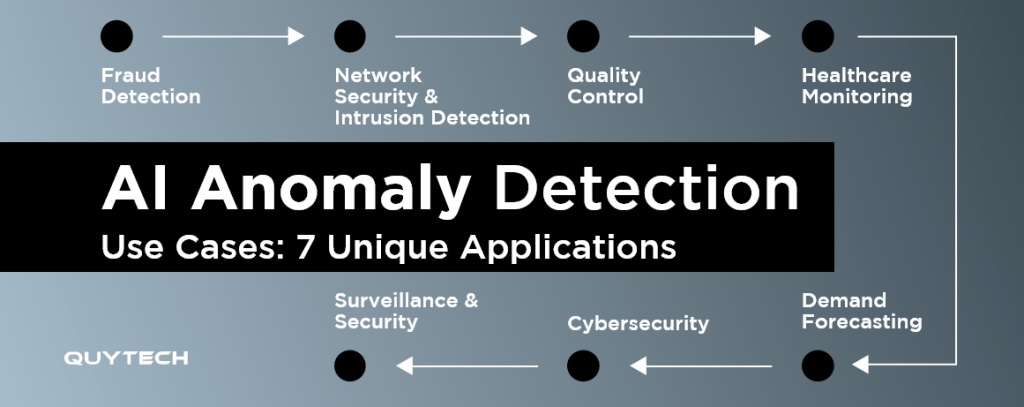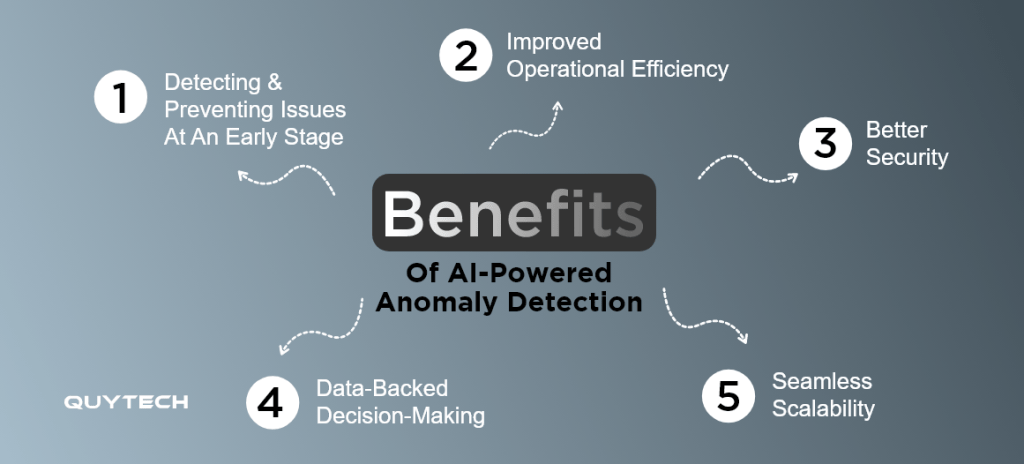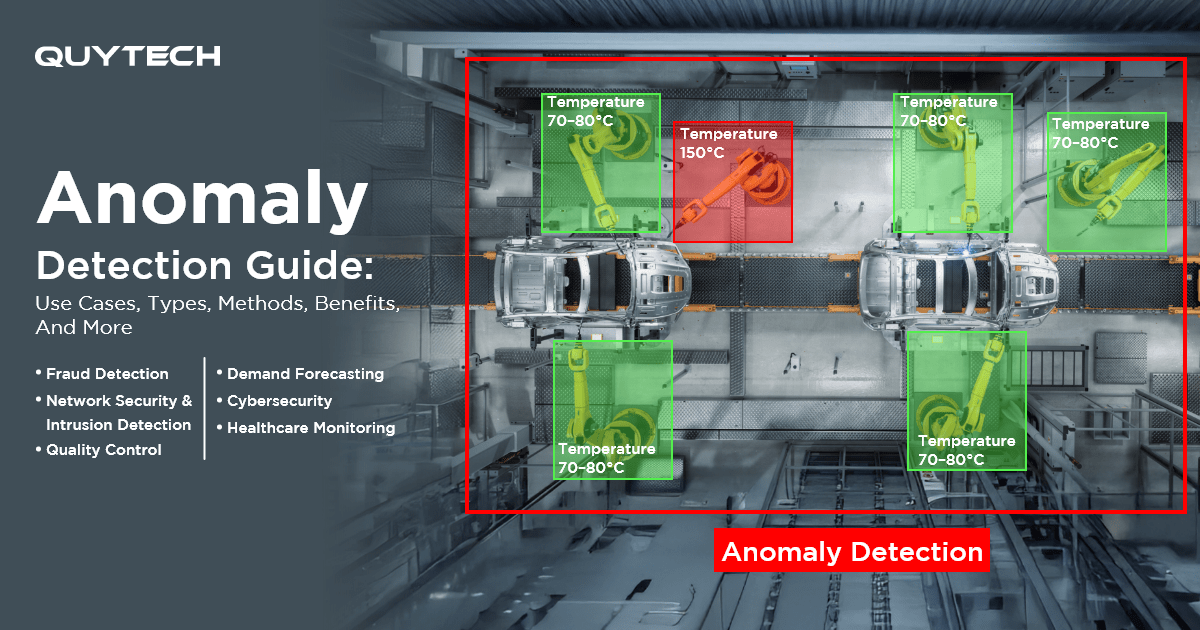Quick Summary: This AI anomaly detection guide spills the beans on how artificial intelligence utilizes your business data to detect anomalies that could indicate fraudulent transactions, machinery faults, cyberattacks, or a potential health problem, depending on the industry using anomaly detection systems.
Almost every business generates enormous amounts of data, and those who still don’t know how to utilize this data to survive and thrive in the data-driven world may go out of business soon. By utilizing data, we mean using it for anomaly detection, one of the significant use cases of artificial intelligence, machine learning, and data analytics- technologies that are leveling up the data game for global startups and enterprises.
While there are numerous other use cases of these technologies, this blog is solely focused on the most underrated one: anomaly detection. Apart from explaining AI anomaly detection in detail, this AI anomaly detection guide covers its benefits, methods, use cases, and technologies that run in the background to make anomaly detection possible.
Without further ado, let’s begin.
What is AI Anomaly Detection
In simple terms, anomaly means something different, and anomaly detection means detecting what’s different. In short, whatever doesn’t fit the normal data gets flagged as an anomaly.
In technical terms, AI anomaly detection is the process of analyzing events and items and making observations to find their difference from the majority of the data. This analysis or anomaly detection is done to find errors, fraud, network intrusions, and equipment failures or issues. By flagging these unusual occurrences, anomaly detection makes further investigation and action-taking easier and precise.
AI Anomaly detection examples are:
- A fraudulent transaction in banking
- A machine fault in manufacturing
- A cyberattack on a network
- A health problem in patient monitoring
Anomaly Detection: Market Statistics
Before moving on to the use cases or benefits of AI anomaly detection in business, let’s check out some interesting market statistics:
- The global anomaly detection market size is anticipated to reach approximately USD 28.00 billion by 2034.
- The anomaly detection market is projected to generate a revenue of $6.90 billion in 2025.
- North America holds the largest share with over 32% revenue share last year.
- The market is driven by the increasing risks of cyber threats, mainly in healthcare, finance, and telecommunications.

Types of Anomalies You Can Detect with Artificial Intelligence Anomaly Detection
To understand AI anomaly detection thoroughly, it is crucial to go through different types of anomalies that can be detected using this technology. Let’s take a look at the same:
#1 Point Anomalies
Also known as global outliers, this type of anomaly means detecting a single point that is way too different from the expected range. For example, a person who usually withdraws an average of $3000 per month suddenly withdraws $10,000 may be considered an anomaly.
#2 Contextual Anomalies
This type of anomaly detects unusual data points in a particular time, location, and condition. It is also known as a conditional anomaly or outlier. For instance, a smart meter detects high consumption of electricity past midnight in a household.
#3 Collective Anomalies
Also known as pattern outliers, collective anomalies detect a group of data points that are normal when done individually, but abnormal when observed together. For example, login attempts of a single account from multiple devices using different IP addresses at the same time can indicate a cyberattack and, hence, be detected as an anomaly.
You may like to read: How Does AI Video Analytics Help Detect Threats in Real Time?
#4 Spatial Anomalies
Spatial anomalies detect unexpected or unusual patterns in location-based data. For example, anomaly detection when implemented into surveillance systems can detect people entering restricted areas in a facility.
#5 Temporal Anomalies
Time-series or temporal anomalies are responsible for detecting unusual changes in time-based data streams. For instance, an anomaly is detected if the system finds a sudden drop in website traffic during peak business hours.
How AI Anomaly Detection Works
AI Anomaly detection works by learning the normal patterns or behaviors within a specific set of data. It uses various methods that can be statistical, ML-powered, or hybrid. Anomaly detection, when done using ML, requires training models on historical data to comprehend normal behavior and flag deviations in the new data.
Artificial intelligence-powered anomaly detection systems or solutions can detect unexpected events that don’t match normal behavior. They trigger an immediate alert to facilitate real-time response and decision-making.
Difference Between AI Anomaly Detection and Traditional Anomaly Detection
The aim of this AI anomaly detection guide is not just to mention inside outs of AI-powered anomaly detection, but also to help you understand how it is different from the traditional way of detection.
| Aspect | Traditional Anomaly Detection | AI-Powered Anomaly Detection |
| Approach | It follows a rule-based approach with a statistical threshold. | Leverages machine learning and deep learning models that learn patterns automatically. |
| Data Requirements | It can handle small and structured datasets. | AI anomaly detection can efficiently work on large, complex, and even unstructured datasets of different formats and types. |
| Adaptability | This type of anomaly detection requires manual updating in case of a change in patterns. | AI-powered anomaly detection can automatically and continuously learn and adapt to evolving data and behaviors. |
| Precision | Limited | Highly accurate |
| Use Cases | Can be used for quality control, simple fraud checks, and threshold alerts. | Some use cases of artificial intelligence anomaly detection include cybersecurity, predictive maintenance, real-time surveillance, and healthcare monitoring. |
| Scalability | Scalability is a challenge in traditional anomaly detection. | This can be easily scaled to big data and real-time monitoring. |
Anomaly Detection Vs Outlier Detection
The previous section of this AI anomaly detection guide highlights how AI-powered anomaly detection is different from manual one. However, in this section, we are providing a detailed difference between AI anomaly detection and outlier detection, which are sometimes used interchangeably but have significant differences:
| Aspect | AI Anomaly Detection | Outlier Detection |
| Objective | Identify rare and significant deviations | Identify extreme values |
| Contextual Relevance | High; totally depends on domain knowledge | Low; statistical focus |
| Use Cases | Fraud detection, network security, and others | Data cleaning and preprocessing |
| Methodology | Machine learning, statistical models | Statistical tests, distance measures |
| Interpretation | Requires expert analysis | Often self-explanatory |
Use AI-driven anomaly detection when the objective is to detect rare events that indicate critical issues, such as fraud or system failures.
Use outlier detection during data preprocessing to identify and possibly remove extreme values that could impact analysis.
AI Anomaly Detection Use Cases: 7 Unique Applications

#1 Fraud Detection
AI-powered anomaly detection can be used to detect unusual patterns in transactions that may result in fraud or financial loss. For instance, a credit card company can use an anomaly detection system to review transactions made by a credit card holder using their card in some other country.
Read More: Fraud Detection System Development: A Comprehensive Guide
#2 Network Security and Intrusion Detection
Cybersecurity service providers can utilize anomaly detection to monitor traffic and find suspicious activities that look different from normal network traffic and behavior. For example, a company’s firewall with anomaly detection capabilities can detect a sudden increase in the transfer of data from an internal server to an unrecognized or unauthorized IP address. This could result in a data breach.
#3 Quality Control
Anomaly detection systems, when connected with quality control systems and IoT sensors, can automatically detect defects or abnormalities in equipment before they turn into large-scale failures. For instance, anomaly detection can work together with a production line to observe even slight vibrations in equipment or the conveyor belt motor. Based on the alert, enterprises can take preventive measures.
#4 Healthcare Monitoring
With real-time anomaly detection in CCTV surveillance for healthcare monitoring, hospitals and healthcare institutions can monitor patient vitals and mark anomalies that may lead to injuries or health risks. For instance, a heart monitor can send an immediate alert to the medical professional in case the patient’s heartbeat is irregular.
You might be interested in: AI in Remote Patient Monitoring: Improving Healthcare Accessibility and Convenience
#5 Demand Forecasting
Retail companies can leverage anomaly detection to identify unusual sales patterns or signs of theft or sudden demand. Based on the detected anomalies, retailers can make necessary adjustments. For instance, if an anomaly detection system, working with the returns management system, detects an increase in the number of returns of a particular product, it will prompt an immediate investigation into the defect in that product.
Explore More: AI in Demand Forecasting: Use Cases, Benefits, and Implementation
#6 Cybersecurity
Anomaly detection can be used in cybersecurity to flag indicators of a possible cyberattack. For instance, an IT team working in a multicloud environment can easily detect anomalies to identify overlapping systems and configurations. Apart from cybersecurity, anomaly detection can also help IT teams to monitor servers, applications, and network infrastructure for irregularities such as traffic spikes, resource usage-related anomalies, and system failures.
You may like to read: Why AI Facial Recognition System is the Future of Cybersecurity?
#7 Surveillance and Security
Using anomaly detection for surveillance and security is one of the best applications of AI anomaly detection. It enhances security, situational awareness, and public safety by analyzing video feeds and images to spot unusual activities and objects and facilitate immediate incident response.
You may like to explore: AI-Powered Video Analytics for Public Sector
How Anomalies Impact Key Business Metrics
Different businesses have different metrics to measure the bottom line and customer experience. AI-powered anomaly detection can make a significant difference by detecting even minor anomalies and helping the business improve them. Let’s understand these metrics, type of anomalies, their impact, and the role of AI in anomaly detection with this dedicated section of the AI anomaly detection guide.
| Business Metric | Type of Anomaly | Example of Impact | How AI Detects It |
| Revenue | Sudden drop or spike | Unexpected revenue dip due to fraud or a system glitch | AI detects deviations from historical revenue trends |
| Customer Transactions | Outliers in frequency/amount | Unusually high purchase volume or abnormally large transactions | AI flags unusual transaction patterns by analyzing the user’s previous history |
| Operational Cost | Unusual increase | Unpredicted surge in cloud server or network usage | Artificial intelligence monitors baseline cost patterns and raises alerts for unusual spikes |
| Website Traffic | Traffic spikes/drops | Chatbots causing a rise in visits or sudden user loss due to outages | AI anomaly detection tracks normal traffic flow and detects abnormal fluctuations |
| Conversion Rate | Sudden dip | Checkout failure or UX issue leading to lower sales | AI detects sudden drops compared to average conversion benchmarks |
| Inventory Levels | Stock anomalies | Sudden out-of-stock events or unexpected overstock | AI monitors supply/demand balance against forecasts |
| System Uptime | Service outages | Unexpected downtime in critical systems | AI detects anomalies in performance logs and alerts before failure |
5 Key Benefits of AI Anomaly Detection in Business
Some of the core benefits of AI anomaly detection in business are:

#1 Detecting and Preventing Issues at an Early Stage
With AI anomaly detection, businesses can identify unusual or unexpected patterns as well as behavior at an early stage. This prevents further escalation of those issues into big problems. Anomaly detection, mainly the one powered by artificial intelligence, also prevents operational disruptions while minimizing potential damage.
#2 Improved Operational Efficiency
With anomaly detection, businesses can optimize maintenance schedules and prevent costly emergency repairs or equipment/vehicle breakdown. In the case of software, anomaly detection can help prevent fraud-related losses. This also reduces the costs associated with the loss.
#3 Better Security
Improved security is one of the biggest benefits of anomaly detection in business. It strengthens the security system by detecting unusual behavior, transactions, unauthorized access attempts, and malicious network traffic. Improved security prevents fraud, which can not only impact a business’s reputation but also result in loss of sensitive customer information and money.
#4 Data-Backed Decision-Making
AI-powered anomaly detection flags anomalies and sends real-time insights and alerts to authorized personnel. With these alerts, authorities can take immediate action and build data-driven strategies for the future.
#5 Seamless Scalability
Anomaly detection systems with AI capabilities and ML algorithms can learn and detect anomalies in new data without manual intervention. It means they can scale without manually training them on new datasets.
Top Algorithms for Anomaly Detection [CREATE CARDS FOR THIS SECTION]
AI and machine learning algorithms set the foundation for anomaly detection. Let’s take a look at the most widely and commonly used algorithms:
Card 1: Isolation Forest
How it works: Randomly partitions data points and isolates anomalies that further need only a few splits.
Suitable for: High-dimensional datasets and large-scale apps.
Benefits it offers: Efficient and highly scalable.
Card 2: Autoencoders
How it works: These are neural network models that reconstruct input data and detect anomalies if the reconstruction error is high.
Suitable for: Complex datasets, which include images, videos, and time series.
Benefits it offers: Effective handling of non-linear relationships.
Card 3: Local Outlier Factor
How it works: Compares the local density of a data point with its surrounding points.
Suitable for: Datasets with different densities.
Benefits it offers: Figures out context-based outliers in local datasets.
Card 4: DBSCAN (Density-Based Spatial Clustering of Applications with Noise)
How it works: Combines closely-packed points and label points to mark sparse points as anomalies.
Suitable for: Spatial data
Benefits it offers: No pre-defining of numbers required for clusters
Card 5: Elliptical Envelope
How it works: Creates an ellipse around most of the data points and marks anomalies to those lying outside.
Suitable for: Works perfectly on data with a Gaussian distribution.
Benefits it offers: effective statistical outlier detection
Card 6: XGBoost
How it works: It’s a gradient boosting algorithm that treats and detects anomalies.
Suitable for: Tabular and structured datasets.
Benefits it offers: Next-level accuracy and production-ready.
Please note that choosing any of these algorithms for anomaly detection depends on the type of data, scalability, specific business goals, and other factors.
Which Industries Can Leverage Artificial Intelligence-Backed Anomaly Detection
Anomaly detection use cases that have been mentioned in the previous section of this AI anomaly detection guide can be used in various industries, including banking, healthcare, manufacturing, retail, and e-commerce. Let’s explore more to know industry-specific use cases of anomaly detection:
#1 Banking and Finance
It can be used to detect unusual financial behavior to prevent fraud and ensure adherence to industry regulations and compliance.
- Fraudulent transaction detection
- Money laundering pattern identification
- Credit card charge-related anomaly alerts
#2 Healthcare
The healthcare industry can leverage artificial intelligence anomaly detection to monitor patient health data and medical operations to find abnormalities or risk factors.
- Irregular heartbeat or vitals
- Abnormal lab test results flagging
- Medicine overdose detection
Similar Read: AI Fall Detection for Hospitals and Elderly Care
#3 Manufacturing
AI anomaly detection in manufacturing contributes to ensuring uninterrupted production by detecting machine or equipment faults and quality issues.
- Predictive maintenance for equipment
- Defected product or assembly line detection
- Flagging abnormal vibration in machinery
#4 Retail and E-Commerce
Anomaly detection in retail and e-commerce spots unusual sales patterns and website traffic to prevent revenue loss and cyberattacks.
- Sudden drop or spike in sales
- Cart abandonment anomalies
- Unusual website traffic
- Bot attack alerts
Similar Read: Developing Queue Detection AI Systems for High Traffic Scores
#5 Telecommunications
Two major benefits of AI anomaly detection in business, especially in the telecommunications sector, are to monitor network traffic and usage patterns.
- Detection of network intrusions and cyberattacks
- Abnormal data usage
- Fraudulent SIM card activity
#6 Energy & Utilities
AI anomaly detection for the energy and utilities sector can do wonders by optimizing energy usage and preventing outages with real-time monitoring.
- Flagging a sudden spike or drop in utilities
- Detecting faults in power grid equipment
- Predicting abnormal demand usage
Read More: AI in the Energy Sector: How AI Enhances Resource Management and Sustainability
#7 Transportation and Logistics
Implementing AI-powered anomaly detection in the transportation and logistics industry can ensure the safety of the fleet and shipments.
- Detection of unusual route deviation of delivery vehicles
- Detection of anomalies in cargo temperature
- Abnormal fuel consumption alerts
#8 Surveillance and Security
With AI anomaly detection in surveillance and security, businesses and security service providers can enhance safety by identifying suspicious activities in real-time.
- Suspicious activities detection
- Unauthorized entry detection
- Loitering in unusual locations
Read More: Suspicious Behavior Detection Systems in Banks: Complete Development Guide
Technologies and Techniques Used in Anomaly Detection
Several technologies and techniques run in the background to make anomaly detection work. Here is a list of them:
#1 Statistical Methods
This type of anomaly detection method relies on mathematical models and thresholds to flag irregularities. Statistical methods include z-score, interquartile range (IQR), Grubbs’ test, and Tukey’s range tests to deliver output. This type of anomaly detection works perfectly with small datasets.
#2 Machine Learning Techniques
Another method that anomaly detection uses is machine learning. The technology enables an anomaly detection system to learn complex patterns from large datasets. From supervised learning and semi-supervised learning to unsupervised learning, anomaly detection uses these methods to identify anomalies across different data types.
#3 Data Learning Methods
Anomaly detection uses deep learning techniques and neural networks to process large, high-dimensional, and sequential data to detect anomalies. It uses autoencoders, long short-term memory networks, generative adversarial networks, and conventional neural networks to offer highly accurate detection of intricate patterns.
#4 AI and Big Data
Advanced anomaly detection utilizes artificial intelligence and big data technologies to get data from multiple sources and process it to detect anomalies. Besides, it also utilizes edge computing to process the data closer to the source.
Implementation Techniques for Anomaly Detection
Now that you have read almost every crucial aspect in this anomaly detection guide, let’s take a look at the steps to implement it into your business processes or operations:
Define Your Strategy
- Set Clear Goals: The first thing you need to ensure is to define what anomalies you want to detect. Depending on your needs, it could be fraud detection, equipment failure, or understanding a shift in customer behavior. When you define this, also specify the metrics on which you will compare the performance of the anomaly detection system.
- Understand Your Data: Next is to define the type of data, the sources from which it will come, and the frequency of data analysis.
Data Preparation and Model Training
- Pre-process Your Data: Once you define the basics of data, it is time to make it ready for model training. For this, clean, normalize, and handle missing values to have the assurance that the model will be trained on high-quality data. Make sure the datasets don’t have bias.
- Select the Right Model: Depending on the specific needs of the data and its volume, select from existing ML or deep learning models. Use the prepared datasets to train and validate models. Test the model for accuracy and performance.
Operations and Monitoring
- Implement Real-Time Monitoring: Build and deploy anomaly detection systems that can efficiently detect anomalies to minimize risks and downtime.
- Integration with Existing Systems: Verify the anomaly detection pipelines for their seamless integration with your current infrastructure.
- Create Incident Response: Create well-defined workflows to define the process after the detection of an anomaly. This will automate the execution of actions like “auto block,” “alert human analysis,” “trigger another verification,” and others.
Continuous Improvement
- Monitor and Tune: Regular monitoring of the designed model is required to ensure the model performs as expected and it remains updated with the new data to deliver accurate outputs, i.e., detect anomalies.
- Balance Sensitivity: Make sure you avoid too many false positives by fine-tuning thresholds.
- Explain Everything: Leverage explainable AI techniques to make anomaly detection easy to understand for everyone using the system.
If you don’t want to try your hand at anomaly detection system development or implementation, contact a reputed AI development company with prior experience in the same.
Explore the Complete Potential of AI-Powered Anomaly Detection with Quytech
Quytech is a leading AI development company with a background in building basic rule-based to advanced AI- and ML-powered anomaly detection solutions. These solutions are capable of processing vast datasets in different formats, images, videos, and texts, to detect anomalies and enable organizations to adopt a proactive approach.
The anomaly detection systems that we have developed have helped organizations to reduce security risks, identify fraud, prevent equipment or machinery failures, and optimize operations. We have built over 100 AI-powered anomaly detection systems for retail, e-commerce, healthcare, banking, finance, manufacturing, and other industries. Some of our top anomaly detection systems include an AI-powered fire detection system, a fall detection system, and a suspicious behavior detection system.
Final Words
Anomaly detection using AI goes way beyond ordinary irregularity detection; it offers predictions to prevent the occurrence of anomalies. Traditional anomaly detection is rule-based and works on small datasets only, whereas AI-powered anomaly detection brings unmatched accuracy, speed, and scalability to make the system capable of automatically processing new data to detect complex anomalies. Give this AI anomaly detection guide a thorough read to understand more about anomaly detection, the benefits of AI anomaly detection in business, anomaly detection vs outlier detection, and more.
FAQs
– Fraud detection
– Network security
– Finding defects in production lines
– Detecting unusual patient vitals
– Recognizing sudden spikes or drops in sales.
– Identifying suspicious account activity.
– Monitoring abnormal energy consumption
– Statistical methods
– Machine learning methods
– Deep learning methods
– To identify fraud and suspicious activities early
– To prevent financial and operational losses
– To improve decision-making with real-time insights
– To enhance security and risk management
– To ensure system reliability and uptime
– To help in maintaining compliance and governance
– AI implementation changes rule-based approach to adaptive learning
– AI detects unknown and evolving anomalies
– AI handles large-scale, real-time data efficiently
– AI ensures higher accuracy with fewer false alarms
– AI offers predictive insights
– Data quality and labeling challenges
– Dealing with imbalanced datasets
– Integrating with cloud and edge platforms
– Regulatory and compliance considerations
– High false positives
– Large data requirements
– Model retraining needs



